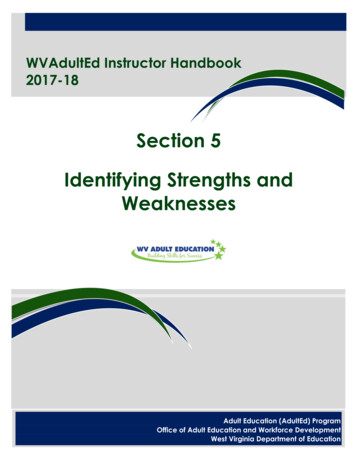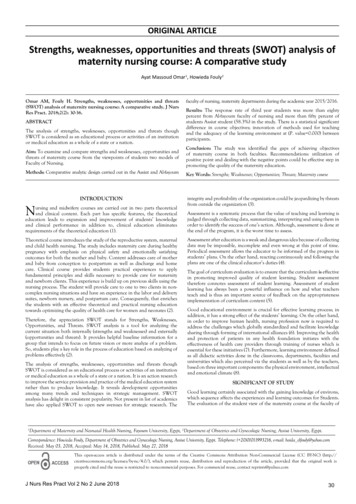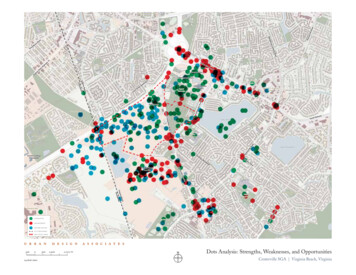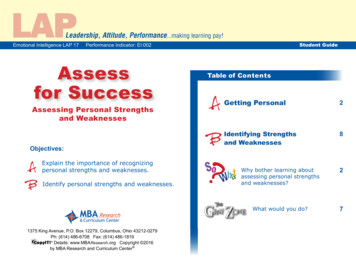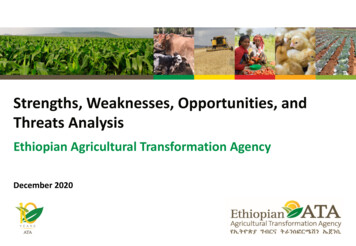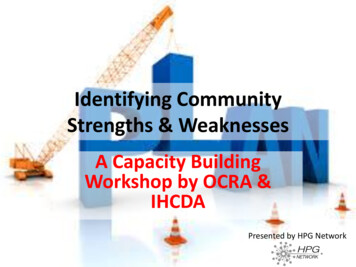
Transcription
Identifying CommunityStrengths & WeaknessesA Capacity BuildingWorkshop by OCRA &IHCDAPresented by HPG Network
S-W-O-T
A SWOT is the first step in a typicalplanning processSelf-Assessment
What is a Plan? Sequence of stepsMethod of getting to your goalRecipe for actionImage of the future as you hope it will unfoldMORE THAN JUST TALK!
Why is Planning Important Clarify choicesLet everyone know what happens nextAvoid or anticipate difficultiesProvide inspiration
Why is Planning Important Clarify choices Let everyone know what happens next Avoid or anticipate difficulties Provide inspiration
Clarify Choices Know what paths you did NOT choose andwhy Consider various different ideas and solutions Build a foundation for commitment
Why is Planning Important Clarify choices Let everyone know what happensnext Avoid or anticipate difficulties Provide inspiration
Let Everyone Know What HappensNext This keeps individuals plugging away Provides basis for teamwork Be sure to include timelines & guidelines forimplementation
Why is Planning Important Clarify choices Let everyone know what happens next Avoid or anticipate difficulties Provide inspiration
Avoid or Anticipate Difficulties Shortages of money Uncooperative groups, officials, residents Planning helps to anticipate, avoid or workaround identified issues
Why is Planning Important Clarify choices Let everyone know what happens next Avoid or anticipate difficulties Provide inspiration
Provide Inspiration Everyone knows the sequence of activities isleading toward a goal that is important to thegroup Plan becomes a source of inspiration Provides assurance that it’s all goingsomewhere Periodically calls for re-assessments that maybe perfect opportunities for celebration
Planning Best Practice TipInclude a schedule for future updates tothe planning document in order to keep itfresh
Find your latest update to yourcommunity plan & decide when itshould be revisited.
Overview of a Typical PlanningProcess
Typical Planning Cycle Preparation for SWOT AnalysisSWOT AnalysisVisioningPlan CreationImplementationCheck-ins / Revisions to the Plan
Preparation for the SWOTDefine/Refresh Data Related toExisting Conditions That AreAffecting Your Community
Review Past Plans Important step Time saver Excellent baseline data to show where thecommunity has been
Economic Factors AffectingCommunities Economic conditionsPopulation characteristicsLabor force characteristicsPhysical conditionsBusiness climateKnowledge-based resourcesQuality of life
Economic Conditions UnemploymentTypes & sizes of firms/industriesWagesIncomeNew business startsRetail salesHousing pricesAssessed valuationTypes of imports/exports# of businesses closed
A Brief Note On AssessedValuation
Population Characteristics Population sizePopulation growthAgeEducation levelEducation attainment & k-12 public schoolenrollment
Population Analysis TipBreak down population growth intocategories to better understandwhich part is growing or declining
Labor Force Characteristics Labor force participationOccupationSkillsCommuter characteristicsProductivityPer capita income
Physical Conditions Land useZoningLand valuesCondition of buildingsVacancy ratesBuilding activityParking facilitiesCondition & capacity of infrastructureAir/water quality
Business Climate Community attitudesLabor relationsBusiness taxes and regulationsLevel & quality of municipal servicesWorkforce trainingAccess to & cost of capitalPublic & private infrastructure
Knowledge-based Resources Federal labsScience & research parksIndustry incubatorsColleges & universitiesTechnical training schools
Quality of Life Housing availabilityPublic servicesEducation systemCrime rateCultural & recreational activitiesParks & other natural amenities
Make a list of other types of dataand/or analysis you need for yourdata refresh.
Typical Planning Cycle Preparation for the SWOT SWOT Analysis Visioning Plan Creation Implementation Check-ins / Revisions to the Plan
Engagement is Key Works best when you haveestablished a regularcommunication process so thatrelationships & trust grow &strengthen over time
Community EngagementConsiderations What level of participation are we seeking?Who are my primary stakeholders?Communications / materialsResourcesTime limitationsTimely feedback & next stepsMethods
Tools for Community Engagement Surveys – photography, poetry, artworkCommunity MappingModelingPublic Meetings, CharrettesWorkshops & Focus GroupsForumsSocial Media / Web-based EngagementOutdoor displays / idea walls / graffiti walls
Get Input from Stakeholders Factors within & outside of the control of localgovernment that impact & shape the localeconomy Identify strengths & opportunities Don’t forget about weaknesses & threats
Know Your Community See how it fits into the broader region Local economic success depends on regionaleconomic success
Questions to Ponder What industries in your community & regionare growing? Struggling? What are the skills of your workforce? Are they sufficient to meet the needs ofbusinesses?
More Questions to Ponder What barriers & support services exist forlocal entrepreneurs & small businesses? Is the local & regional housing stock diverseenough to provide for a wide range of housingneeds? If someone were to come to your communitytomorrow, what would they find attractive?Unattractive?
Result of This Process? Stronger sense of your unique local assets What you can & should be doing to build onstrengths & mitigate weaknesses
Make a list of stakeholders you wouldlike to engage for your communityplanning processes.
How To Identify Your Community’sStrengths & WeaknessesThink of a community problem thatyou believe needs to be resolved
Why Identify Strengths &Weaknesses? Develop a shared understanding of theproblem(s) you’re trying to deal with Raise the level of awareness about root causesof identified problem(s) Identify root causes
Question & Answer ApproachDEVELOP YOUR ANALYSIS
Question-and-Answer Approach What is the main problem that concerns ourcommunity? Why is that a problem?– Repeat until root causes become apparent Who/what causes the problems? How?
Question-and-Answer Approach What would it take to really eliminate theproblem?– Is this an individual/institutional problem or is it asystemic problem
Question-and-Answer Approach What are our “leverage points” of potentialinfluence over these powerfulgroups/institutions? How can our community tie into this situationin a powerful way?
Write down your conclusions usingthis Q & A approach.
Exercise in Analytical ThinkingLet’s try looking at someone else’sproblem
Analytical Thinking Problem: many people in our community livein sub-standard housing – perhaps as many as15%
Possible Causes Residents are too poor to afford any betterhousing Local officials turn their backs on codeviolations Landlords more concerned about profit thanbuilding maintenance Banks have redlined certain neighborhoods sothat improvement loans aren’t available
Analytical Thinking Possible causes focus on “Who should we goto get some leverage on the problem” Choose a possible cause and analyze how youmight go about solving it
Possible Causes Residents are too poor to afford any betterhousing Local officials turn their backs on codeviolations Landlords more concerned about profit thanbuilding maintenance Banks have redlined certain neighborhoods sothat improvement loans aren’t available
Things to Consider What are some possible explanations of thereasons for the problems? How do you choose among competingexplanations? What factual information will be relevant?
Things to Consider (cont’d) What can you do when members of yourcommunity disagree about explanations? How could you raise these analysis questionsduring the meetings & day-to-day functioningof your planning group? Who can be a resource? Who would be agreat partner?
How to Conduct a SWOT AnalysisSETTING UP YOUR SWOT
Disclaimer It’s really not a true analysis, it’s abrainstorming session Do not discuss each item that someone wantsto add to the list Add each item to the list without evaluation The truth-telling session will begin later
Facilitator Experienced in running meetings Slightly knowledgeable about issues or willingto become so in preparation for the session Strong enough to keep the meeting frombogging down in discussion Stay away from anyone with a “dog in thefight” Consider your OCRA community liaison
Resources Needed Recorder (could also be facilitator)Big chartEasel or wall that can accept sticky paperLots of paper
Conducting the SWOT Order steps with the acronym – S-W-O-T Allows you to begin with strengths Insist as many entries as people can think offor each category Be prepared for pauses
Facilitation Tips No strengths categorically untrue No weaknesses threat may be apathy or lackof watchfulness Get through the brainstorming as quickly aspossible if some analysis can be done later Analysis look for connections between itemslisted
Facilitation Tips Note connections between Strengths &Weaknesses Note connections between Opportunities &Threats Look at both internal & external factors Include items that can be controlled & factorsthat cannot be controlled
Facilitation Tips Think of your community as being in acompetition just as a private business woulddo Relative success at economic development,housing, community organizing, safety &beautification will point to success overall
Following the SWOT If time is short, ask everyone to decide onmost important single community S, W, O or T If time is more abundant, ask people whatsurprised them most about the SWOTs listed Ask group to discuss where research & factfinding are needed
Following the SWOT Assign each SWOT point to a committee forfurther study or action Be sure to publish results or hold a follow upevent for wider & additional discussion
Preparation for the SWOT SWOT Analysis Visioning Plan Creation Implementation Check-ins / Revisions to thePlanNext Steps inthe PlanningCycle
Internal ScanSWOTs Can Also Be ConductedInternally
INTERNAL Environmental ScanWorkshop70
Internal Environmental ScanObjectives1. Gauge the current conditions in theorganization that may impact success inachieving strategic goals
Internal Environmental ScanObjectives2. Engage key internal stakeholders (YOU!) in theprocess of identifying organizational strengthsand limitations72
Internal Environmental ScanObjectives3. Ultimately build a sense of urgency aroundchange and improvement to meet ourchallenges73
74
Strategic Planning Values–Vision Mission– Strategic Priorities»SMART Goals75
Anytown, INCore Values sibility/AccountabilityCooperation76
Anytown Vision Statement:“Commitment to Community”77
Mission Statement“The mission of Anytown is to exhibit integrity ofservice with a commitment to provide: Exemplary public safety Inviting parks and recreational opportunities Compassionate public assistance Responsible historic preservation ofcemeteries and other Towns assets”78
Environmental Scans Objectives– To gauge current conditions internally and externallyof strengths/opportunities that will help us achieveour strategic plan, or weaknesses/threats that mayimpede us from achieving our strategic plan (establisha sense of urgency)– To engage internal and external stakeholders (create aguiding coalition)– In preparation to develop a realistic strategic plan(create a clear shared vision)79
Strategic Planning Values–Vision Mission– Strategic Priorities»SMART Goals80
ENVIRONMENTAL SCANS81
Environmental Scan Structure Use consensus to reach rating decisions Determine whether each factor is a strengthor weakness– A strength is helpful in reaching our objectives– A weakness is harmful to reaching our objectives82
Environmental Scan Structure Use definitions for each factor Determine how critical this factor is inachieving our objectives83
Environmental Scan Scoring Categories Human CapitalOrganizational CapitalKnowledge CapitalResources / Ability to Provide ExcellentServices Work Processes
Human Capital Hiring (timely) qualified employees Training employees
Organizational Capital Structure Governance Teamwork
Resources Asset Management
Work Processes Efficiency Producing desired results Exceeding customer wants, needs, and values
How Critical Is The Function? Measure each element as to whether it’s astrength or weakness Measure how critical it is Result: Weighted metric on areas ofexcellence and those areas needing attention
Write down an internalweakness in your organizationyou would like to see resolved.
SWOT Best PracticesHighlighted Indiana Communities
Town of North LibertyHuntingburg
Huntingburg, Indiana Identified Weakness:Lack of housing in DuBois County What They’re Doing About It:Used SIP to build on this and looked for ways tocreate new housing stock & improve quality oflife to attract families
Town of North Liberty Identified Weakness:Sees more than 200,000 visitors going to PotatoCreek State Park each year, but not visitingdowntown What They’re Doing About It:Improving quality of life and physicallyconnecting the two areas by creating a trailfrom the Park to the downtown
Write down at least 2 followup tasks you would like to dobased upon lessons learnedtoday.
Q&APlease use the right navigation barto enter your questions
Need Help? OCRA staff have been trained in facilitation Contact your community liaison for assistance
Upcoming Courses Building Local Capacity – June 17, 2016Coalition Building – July 17, 2016Public Feedback – August 5, 2016Leveraging Public/Private Investment –September 6, 2016 Fundamentals of Project Management –October 20, 2016
Facilitation Tips Think of your community as being in a competition just as a private business would do Relative success at economic development, housing, community organizing, safety & beautification will point to success overall



